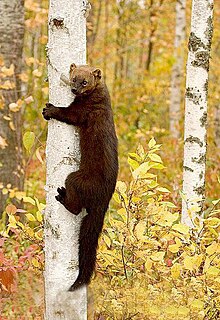
Back بيكان (حيوان) Arabic دلق ARZ Pennant Manyukol (Martes pennanti) AVK مارتس پننانتی AZB Пекан Bulgarian Mart pesketaer Breton Marta pescadora Catalan Martes pennanti CEB Kuna rybářská Czech Virginsk mår Danish
| Fisher | |
|---|---|

| |
| A fisher in New Hampshire | |
| Scientific classification | |
| Domain: | Eukaryota |
| Kingdom: | Animalia |
| Phylum: | Chordata |
| Class: | Mammalia |
| Order: | Carnivora |
| Family: | Mustelidae |
| Subfamily: | Guloninae |
| Genus: | Pekania |
| Species: | P. pennanti
|
| Binomial name | |
| Pekania pennanti (Erxleben, 1777)
| |
| Synonyms | |
|
List
| |
The fisher (Pekania pennanti) is a carnivorous mammal native to North America, a forest-dwelling creature whose range covers much of the boreal forest in Canada to the northern United States. It is a member of the mustelid family, and is the only living member of the genus Pekania. It is sometimes referred to as a fisher cat, although it is not a cat.[3]
The fisher is closely related to, but larger than, the American marten (Martes americana) and Pacific marten (Martes caurina). In some regions, the fisher is known as a pekan, derived from its name in the Abenaki language, or wejack, an Algonquian word (cf. Cree ocêk, Ojibwa ojiig) borrowed by fur traders. Other Native American names for the fisher are Chipewyan thacho[4] and Carrier chunihcho,[5] both meaning "big marten", and Wabanaki uskool.[6]
Fishers have few predators besides humans. They have been trapped since the 18th century for their fur. Their pelts were in such demand that they became locally extinct in several parts of the United States in the early part of the 20th century. Conservation and protection measures have allowed the species to rebound, but their current range is still reduced from its historical limits. In the 1920s, when pelt prices were high, some fur farmers attempted to raise fishers. However, their unusual delayed reproduction made breeding difficult. When pelt prices fell in the late 1940s, most fisher farming ended. While fishers usually avoid human contact, encroachments into forest habitats have resulted in some conflicts.
Male and female fishers look similar, but can be differentiated by size; males being up to twice as large as the females. The fur of the fisher varies seasonally, being denser and glossier in the winter. During the summer, the color becomes more mottled, as the fur goes through a moulting cycle. The fisher prefers to hunt in the full forest. Although an agile climber, it spends most of its time on the forest floor, where it prefers to forage around fallen trees. An omnivore, it feeds on a wide variety of small animals and occasionally on fruits and mushrooms. It prefers the snowshoe hare and is one of the few animals able to prey successfully on porcupines. Despite its common name, it rarely eats fish. The reproductive cycle lasts almost a year. Female fishers give birth to a litter of three or four kits in the spring. They nurse and care for them until late summer, when they are old enough to set out on their own. Females enter estrus shortly after giving birth and leave the den to find a mate. Implantation of the blastocyst is delayed until the following spring, when they give birth and the cycle is renewed.
- ^ Helgen, K. & Reid, F. (2018) [amended version of 2016 assessment]. "Martes pennanti". IUCN Red List of Threatened Species. 2018: e.T41651A125236220. doi:10.2305/IUCN.UK.2016-2.RLTS.T41651A125236220.en. Retrieved March 8, 2020.
- ^ "NatureServe Explorer 2.0". explorer.natureserve.org. Retrieved March 30, 2022.
- ^ "About Fishers". Mass Audubon. Archived from the original on September 2, 2018. Retrieved September 2, 2018.
- ^ "Fort Resolution Chipewyan Dictionary" (PDF). January 22, 2011. p. 40. Retrieved December 21, 2012.
- ^ Poser, William J. (1998). Nak'albun/Dzinghubun Whut'enne Bughuni (Stuart/Trembleur Lake Carrier Lexicon), 2nd edition. Vanderhoof, BC: Yinka Dene Language Institute.
- ^ Cite error: The named reference
Powell1was invoked but never defined (see the help page).

